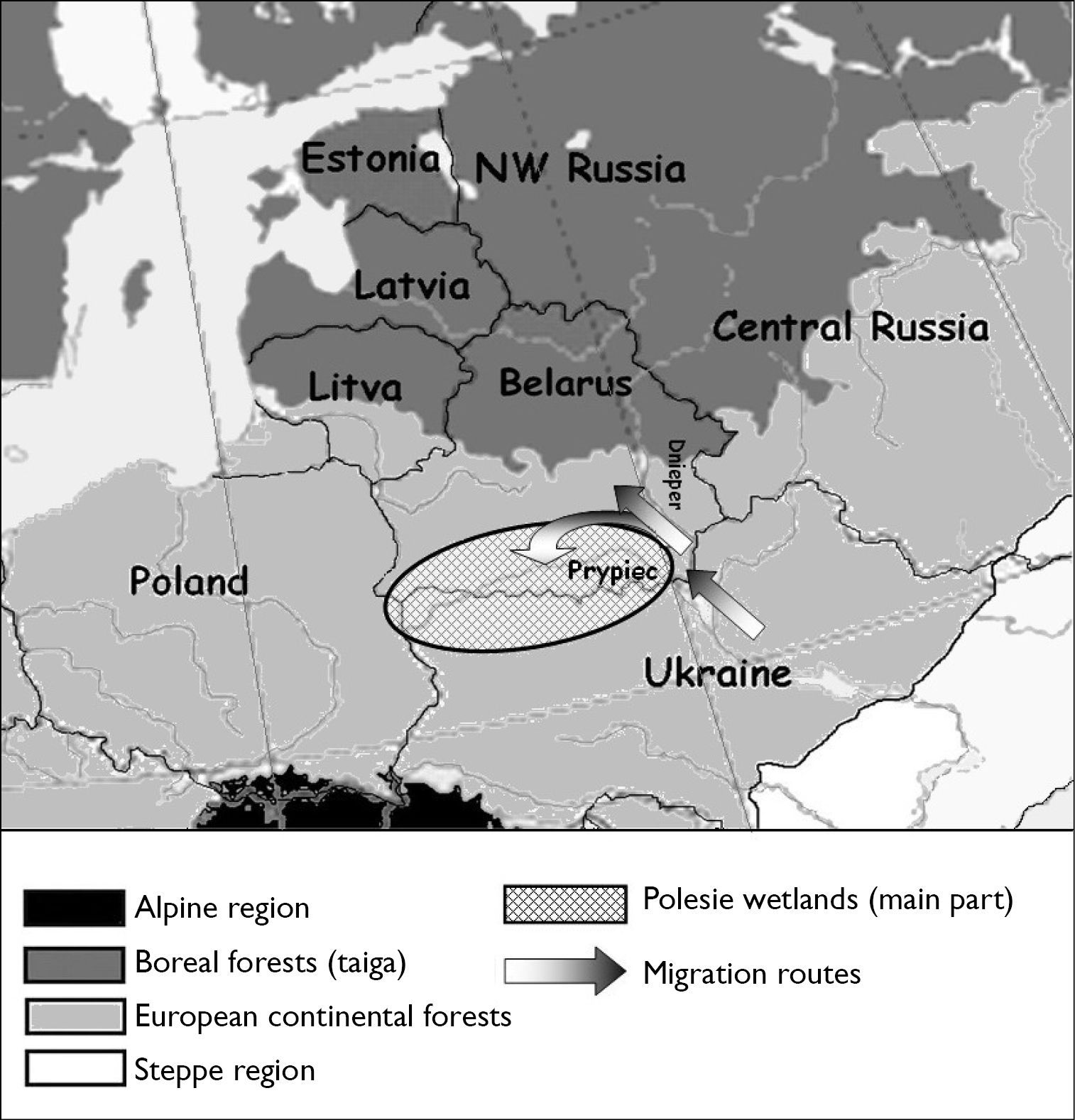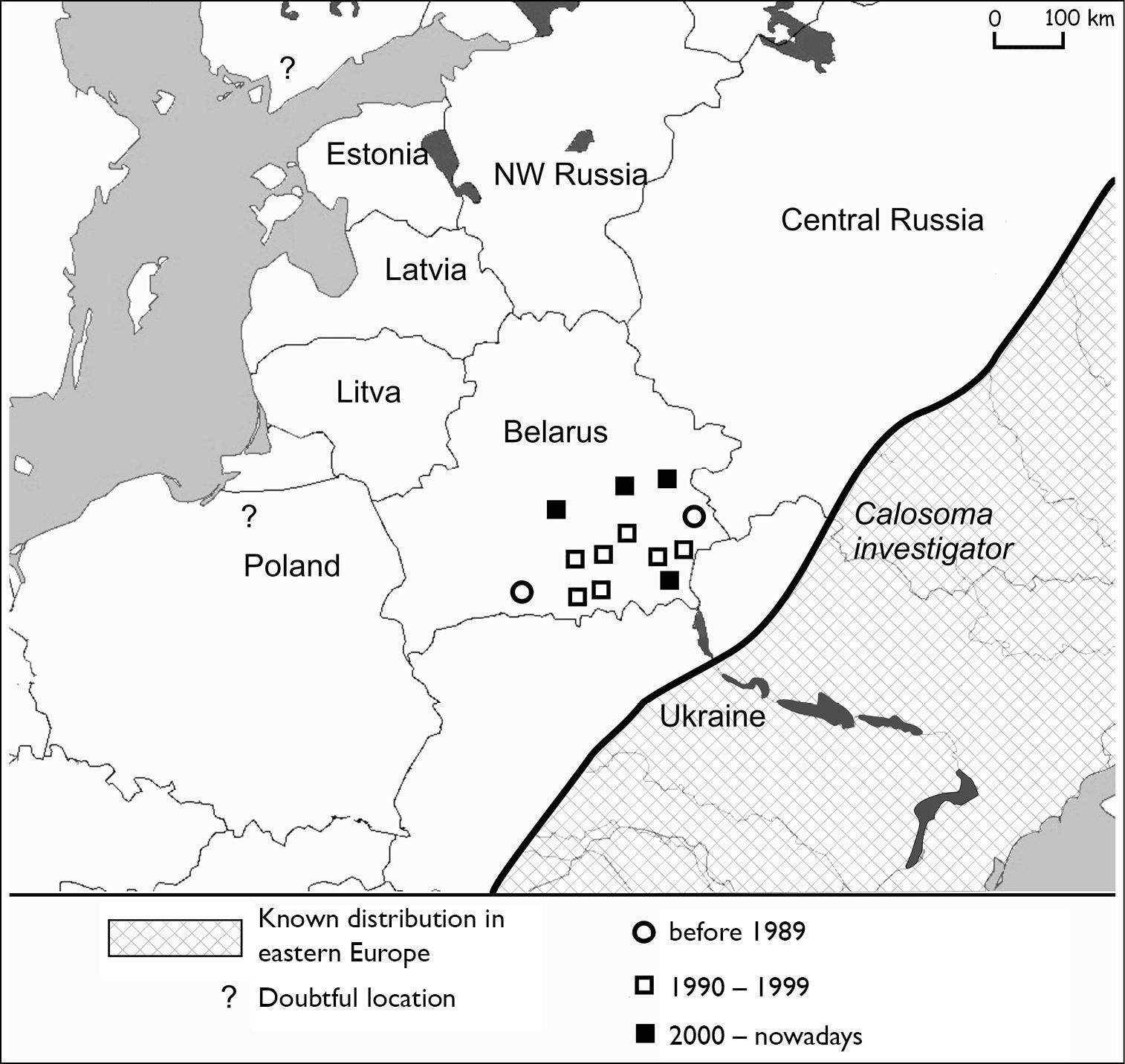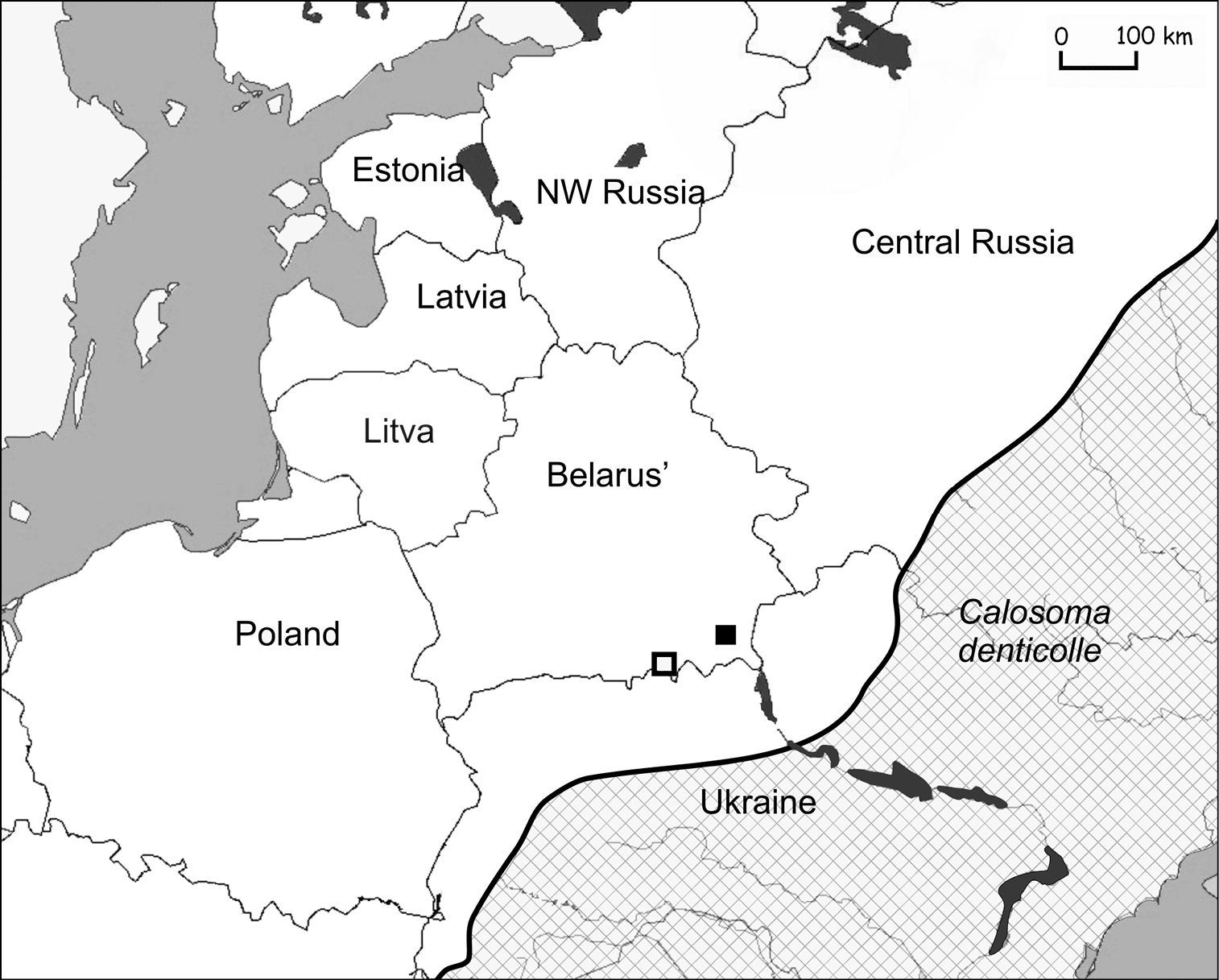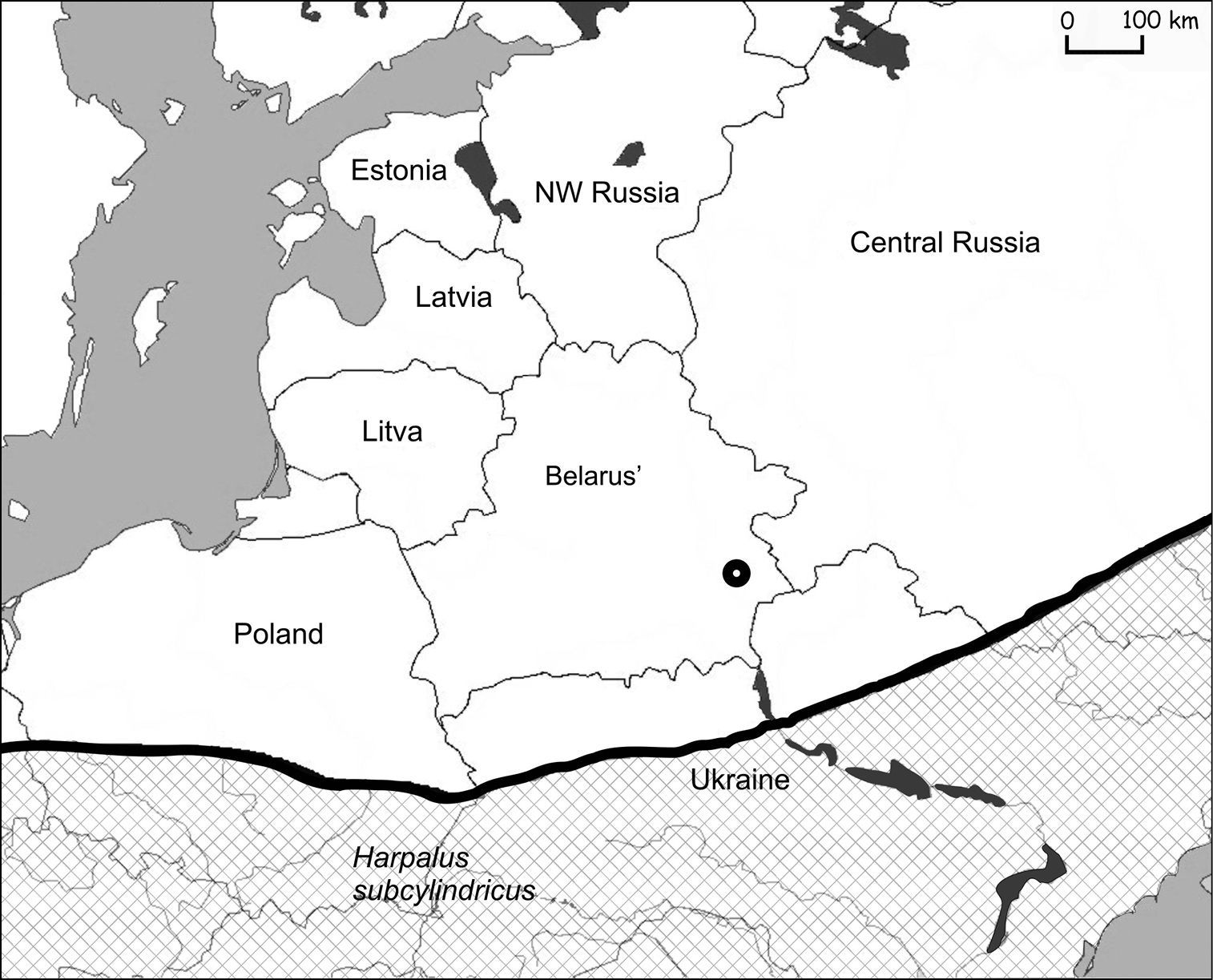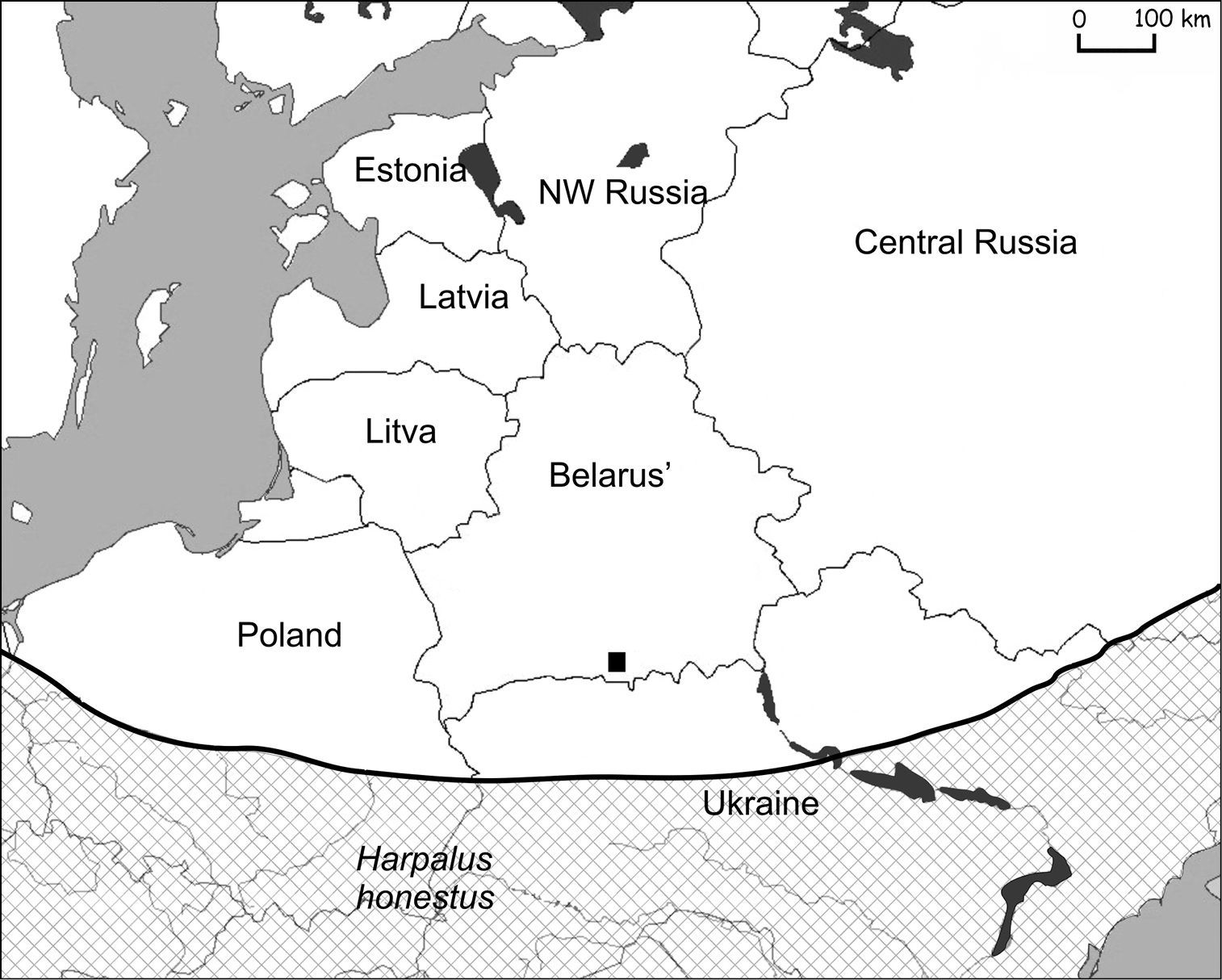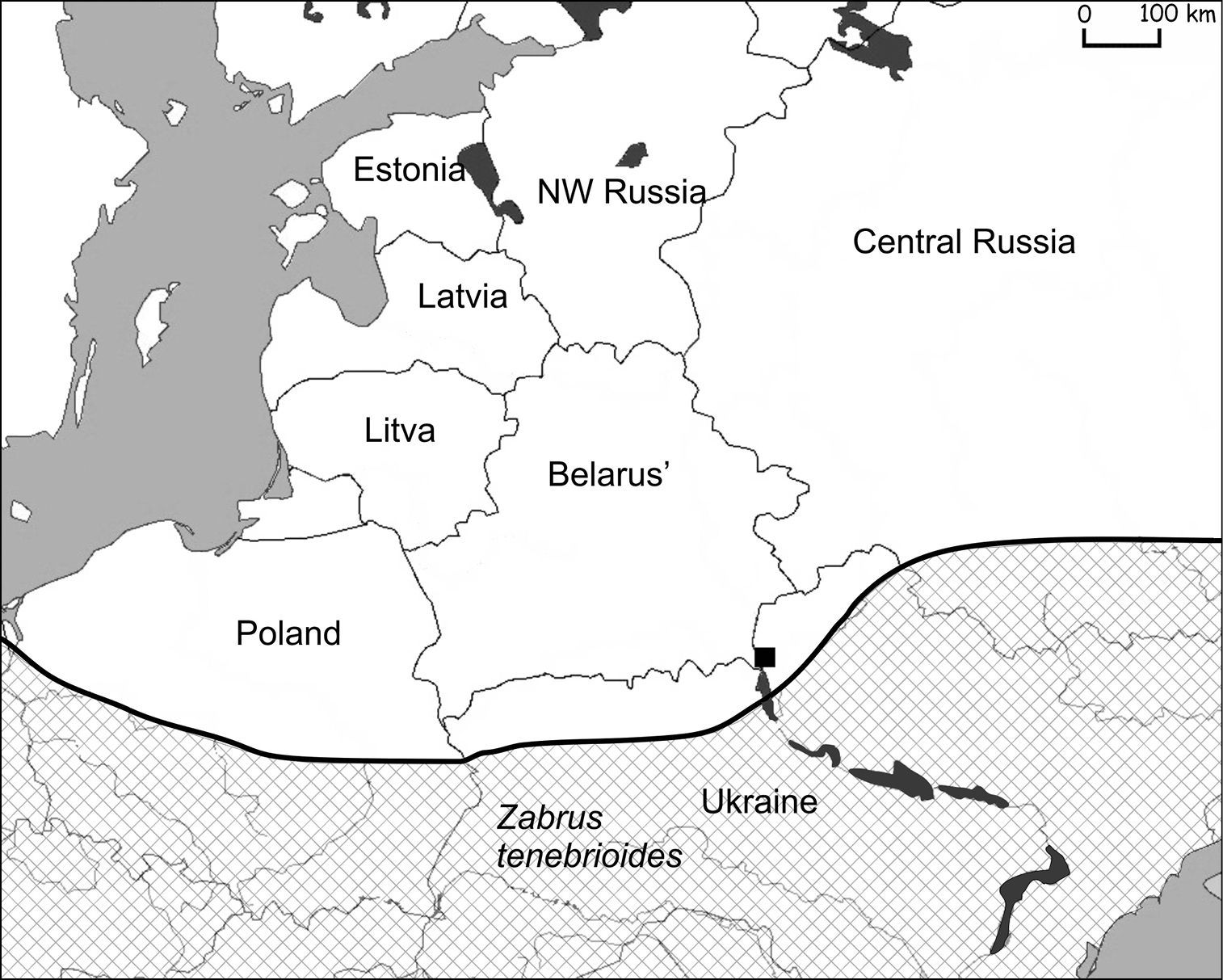






(C) 2011 Oleg Aleksandrowicz. This is an open access article distributed under the terms of the Creative Commons Attribution License, which permits unrestricted use, distribution, and reproduction in any medium, provided the original author and source are credited.
For reference, use of the paginated PDF or printed version of this article is recommended.
Belarus is situated at a crossroad of natural borders of species distributions: the NE part is situated in a taiga zone, whereas the other part of terrain is in the European forest zone. The distance of Belarus to the steppe zone is about 330 kilometers. This geographical position and the extensive knowledge of its fauna can be used to monitor changes in the distribution of different species. An intensive study of open habitat ground beetles was carried out from 1975–2008 in Belarus, using pitfall traps, quadrate-sampling methods, hand collecting, netting and light traps. In total, more than 130 000 specimens of ground beetles belonging to 169 species were collected from 62 fields and 11 meadows of different types. 217 specimens of Calosoma investigator (Illiger 1798), 2 specimens of Calosoma denticolle (Gebler 1833), and one specimen of Harpalus subcylindricus (Dejean, 1829), Harpalus honestus (Duftschmid 1812) and Zabrus tenebrioides (Goeze 1777) were present in this material. All specimens were macropterous and exclusively caught at fields and waste grounds on sandy soil. Nowadays Belarus is the northernmost location for these species in Eastern Europe. Steppe species most probably migrated to SE Belarus from NE Ukraine, using Dnieper and its river valleys. The shift in the geographic distribution of steppe species during the last thirty years in Belarus have been attributed to a higher frequency of warmer and wetter summers in the last few decades.
Carabidae, Belarus, steppe species, geographic ranges
Every aspect of an insect’s life cycle depends on
temperature. As such, these organisms respond quickly to climatic
changes by shifting their geographical distribution. This quick response
allows them to take advantage of new climatic environments. A wide
variety of vertebrate and invertebrate species have moved northwards and
uphill in response to global warming. These changes have already been
documented in Europe (
Similar shifts in geographic distribution were also
documented among well-studied insect groups in Belarus (Eastern Europe).
In the last decade, xerophilous steppe species from different insect
orders were recorded from SE Belarus, for example: Scolia hirta (Schrank 1781) and Megascolia maculata (Drury 1773) (
Belarus is situated at a crossroad of natural borders of
species distributions: according to the biogeographical regionalization
of Europe (
Biogeographic regions and the geographic location of Belarus.
This geographic position makes Belarus ideal for monitoring changes in the geographic distribution of the fauna. Fortunately, the fauna of South East Belarus has been studied extensively, which is well documented in publications and collection material.
At the end of the 19th century the beetles of South East
Belarus were one of the most intensively studied groups within the
Russian Empire. The first checklist of Mogilev province (including the
Mogilev and Gomel regions of Belarus) was compiled by
The faunistic inventory of carabids was continued in the second half of 20th century (
Belarus is situated in eastern Europe, on the eastern of Poland (53°00'N, 28°00'E). The total territory of Belarus is 207.6 thousand km2 (Fig. 1. Landscape and climate).
Climate in Belarus is moderately continental: a transitional form of maritime to continental climate with mild and humid winters, warm summers and damp autumns.
The terrain is generally flat and contains much
marshland, especially in the southern part near the Ukraine border,
which is named Polesie (Fig 1. Wetlands). The Polesie lowlands lie
mainly along the Pripyat river and occupy 80 000 km2. The Polesie area
presents a plain with rare and irregularly distributed hills with flat
tops and gentle slopes. Sand is common in places of higher elevation on
which pine trees are typical. Wide and swampy river valleys are a
characteristic feature of the landscape. The Polesie lowlands are only
100–150 m a.s.l., with the western part slightly higher than the
eastern parn. During the last 20 years, intensive drainage of the
Polesie swamps has occurred. The aim of this activity is to turn the
swamps into hay-fields. Many swamps have disappeared, and many canals
have been cut through the region (
Intensive inventories of open habitat carabids in 1975–1976 were carried out in Belarus Polesie, using pitfall traps and quadrate sampling method (0.25 m2). These studies have been repeated in the area of Luninetz, in the Brest district of Belarus (52°14'26"N, 26°37"E) in 1982–1983.
The entire terrain of Belarus was studied in 1980–1985 during 12 expeditions of the Belarus Institute of Plant Protection. The purpose of these expeditions was to reveal grain crop pests. Hand collecting and netting were used to collect the insects.
Studies were performed by collecting material from light traps in crop fields and orchards of the Gomel Regional Crop Protection Service in 1980–1990.
Later studies (1990-2005) evaluated the effects of insecticide and herbicide spraying on carabid communities in wheat and barley fields in the Minsk and Mogilev districts, using pitfall traps (Central and East Belarus).
In 2005–2008, faunistic inventories were continued in
the east of Polesie: in the vicinity of Gomel and Polesie
Radio-Ecological Reserve, using pitfall traps, netting and hand
collection. The main focus was arable fields and the terrain of the
Prypiatski National Park (
The level of faunistic knowledge in Belarus allows us to
monitor the appearance or disappearance of carabid species. In all
likelihood, steppe species will have colonised Belarus during decent
decades. A steppe species is defined as a species of euroasiatic
subboreal geographic ranges. These species only colonise on open (mainly
arable) habitats with mostly continental climate. This definition is
similar to
In total, during the period 1975–2008, more than 130 000 specimens of ground beetles belonging to 169 species were collected, mainly by pitfall traps from 62 fields and 11 meadows of different types.
Among this material, 217 specimens of Calosoma investigator (Illiger 1798) and 2 specimens of Calosoma denticolle (Gebler 1833) were found. Harpalus subcylindricus (Dejean, 1829), Harpalus honestus (Duftschmid 1812) and Zabrus tenebrioides (Goeze 1777) were represented by only one specimen.
Calosoma investigator is widespread in the steppe zone of Eurasia, from South-East Europe to Baikal (
The distribution of Calosoma investigator in North-East Poland (Ost Preussen) is unclear.
In SE Europe Calosoma investigator is known from the Ukraine, Moldova, Romania, Bulgaria and European Turkey (
In Belarus Calosoma investigator was collected for the first time in 1975 near Luninetz (52°14'21"N, 26°37'46"E) in barley field. Nowadays it can be found up to Slutsk (52°57'40"N, 27°37'27"E) and Bobruysk (52°12'27"N, 29°02'25"E) (Fig. 2).
Actual distribution of Calosoma investigator in Belarus.
At the moment, Calosoma investigator occupies almost the entire southeastern part of Belarus. It inhabits arable lands on sandy soils and are sometimes locally abundant. All of the 217 collected specimens were macropterous. Their expansion rate is estimated at about 50–60 km in 10 years.
The geographic distribution of Calosoma denticolle is limited by the steppe zone of Eurasia, from southeast Europe to northeast China (
In northern Europe only one specimen is known from
southern Finland in an atypical locality. It was collected from the
Baltic shore after a strong gale in 1935 (
In Belarus it was caught for the first time in 1988 near Turov (52°3'33.29"N, 27°44'36.15"E) in an arable field. A second specimen was captured in 2007 near the village Arevithcy in a wasteland (51°36'52.72"N, 29°50'49.50E) (Fig. 3).
Actual catch of Calosoma denticolle in Belarus (□ – 1988; ■ – 2007) and its known distribution in eastern Europe (chequered area).
Harpalus subcylindricus is widespreadfrom southern Europe and southern part of Middle Europe to the Caucasus to West Asia (
Actual catch of Harpalus subcylindricus in Belarus (○ – 1988) and its known distribution in eastern Europe (chequered area).
Harpalus (s.str.) honestus is distributed from southern Europe and southern part of Middle Europe to the Caucasus to West Asia (
Actual catch of Harpalus honestus in Belarus (■ – 1997) and its known distribution in eastern Europe (chequered area).
Zabrus tenebrioides is widespread from southern Europe and southern part of Middle Europe and the Caucasus to Turkey. Distribution of Zabrus tenebrioides
in the former USSR (South-West Russia, Caucasus and Ukraine) has been
studied well because of its economic damage to grain crops (
For the first time, one macropterous specimen was collected in southeastern Belarus near the village Khvashchouka, in a dry meadow in 2007 (51°38'49.18"N, 29°47'3.09"E) (Fig. 6).
Actual catch of Zabrus tenebrioides in Belarus (■ – 2007) and its known distribution in eastern Europe (chequered area).
The data presented most likely show the northern most locations for these steppe species in eastern Europe.
The different types of forests, meadows and marshes (Gorburova 1956,
All steppe species found in these studies were exclusively caught in fields and waste grounds on sandy soils. This seems to confirm the theory of Elton (1958) that migrants invade arable fields or waste grounds first, where competition is lower and migrants can dispersed successfully. Of all the steppe species, only macropterous specimens have been found. Except for Calosoma investigator and Calosoma denticolle the other three steppe species were caught only as single specimens.
The new species probably migrated to the north and to the northwestern part of Belarus from the southeast (connected to the northeast part of the Ukraine). The Polesie lowland, in the south west of Belarus, harbours an extensive complex of marshes and lakes that might act as a natural barrier for migrations from northern Ukraine.
Migrations from the Ukraine probably occurred along the Dnieper river valleys and its affluent: Pripyat, Sozh and Berezina (Fig. 1). The actual distribution of steppe species in Belarus is in the valleys of these rivers (Figs 3–6). Only Calosoma investigator migrated beyond the river valleys and nowadays can be found on arable lands north from this river system (Fig. 2).
The changing of geographic ranges can have an economic impact on the local agricultural society. Calosoma species will probably be beneficial in this case as general predators. But Zabrus tenebrioides is known as a serious pest of winter wheat in eastern Europe and a local pest in central Europe (
Global or local climatic changes is frequently mentioned
as one of the reasons for shifts in geographic ranges. Over a long
period of observation (1881–2001)
This change in temperature makes it plausible that shifts
in the geographic distribution of some insect species during the last
thirty years in the Belarus have been the result of a higher frequency
of warmer and wetter summers. To complete its life cycle, steppe
species need high summer temperatures, which makes it possible for them
to move further north. As in the steppe of the Ukraine and Russia,
winters are colder than in Belarus (
However, in the Polesie region in Belarus, intensification of agriculture and changes in land use (e.g., first of all Polesie’s peat-bog drainage) also took place. This kind of management might also cause shifts in geographic changes. These hypotheses indicate the general problem of separating climatic effects from human effects in interpreting biological patterns.
